During the Middle Ages, wine was not just a luxurious indulgence but a daily necessity. It served as a safer alternative to water, which was often contaminated. The quality and variety of wine would vary greatly, with choices influenced by factors like regional grape cultivation, winemaking techniques, and even medieval wine laws. Vineyards sprawled across Europe as monasteries and nobles recognized the value of wine in trade and society.
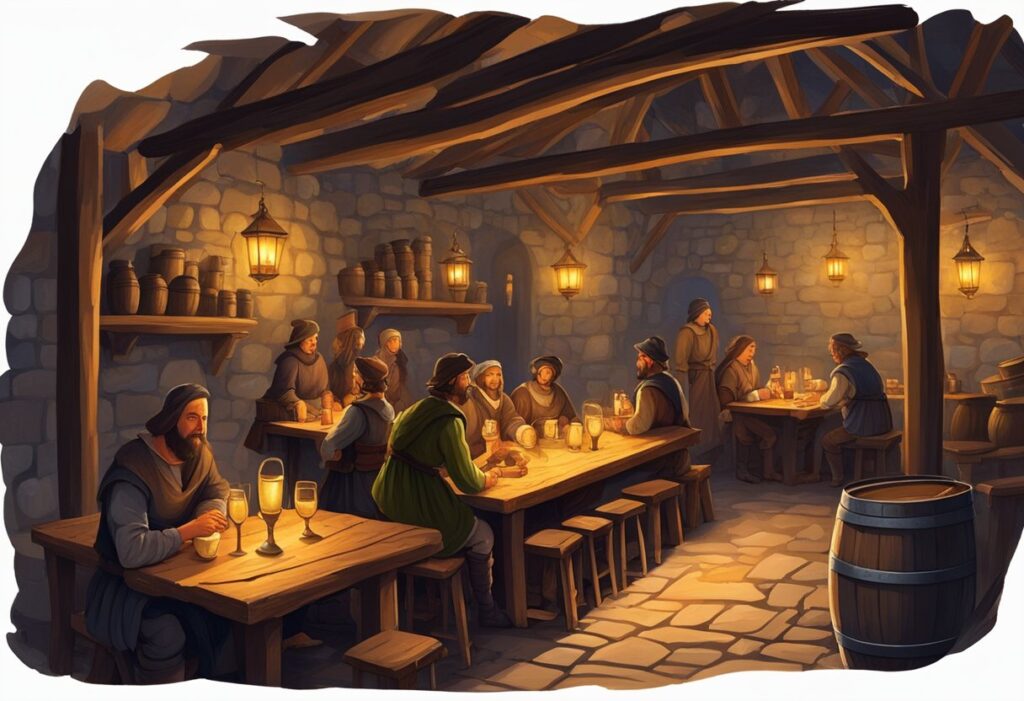
Vintners of the medieval era employed a range of techniques to produce and store wine. The era saw advancements in winemaking that allowed for better preservation and flavor.
Though considered a common beverage, accessible to both the noble and the peasant, the wine you could afford was indicative of your social status. This drink was integral to cultural rituals and was believed to have health benefits, influencing its widespread consumption throughout the medieval period.
Key Takeaways
- Wine was a central part of daily life and trade in the Middle Ages.
- Advancements in winemaking improved preservation and quality.
- Social status influenced the type and quality of wine consumed.
Origins of Viniculture
Viniculture’s foundations are deeply rooted in history, tracing back to ancient civilizations where the craft of winemaking was both an art and a crucial economic activity. These practices laid the groundwork for the sophisticated winemaking techniques of the Middle Ages.
Influence of Ancient Practices
The ancient Greeks and Sumerians were pivotal in the development of viniculture, cultivating vines and perfecting the fermentation of grapes. Their insights contributed to the widespread appreciation and understanding of wine. The Greeks, in particular, integrated wine into their culture and mythology, with Dionysus, the god of wine, symbolizing its significance.
In the context of ancient practices, you might find Neolithic winemaking particularly relevant, as it highlights how the management and propagation of grapevines were advanced for that era. Moreover, viticulture was not isolated in the mediterranean, evidence from Sumer (modern-day Southern Iraq) indicates that these regions also cultivated vines, as mentioned in ancient cuneiform texts.
Advent of Monastic Winemaking
With the rise of the Christian church, monasteries became centers of agricultural knowledge, including the cultivation of grapevines. Monastic orders, such as the Benedictines and Cistercians, took a systematic approach to viniculture, applying rigorous methods to enhance grape growing and winemaking.
The church’s influence perpetuated the growth of wine as a cultural and religious symbol throughout the Middle Ages, firmly rooting it in public and liturgical life.
The practices of these monastic communities were underpinned by knowledge passed down from the ancients, and they often established some of the earliest known wineries. Their contributions to vineyard management and production techniques were crucial in the preservation and improvement of winemaking during this period.
Medieval Vineyard Expansion
The medieval period saw a significant expansion of vineyards across Europe, fueled by climate changes and regional developments. Your understanding of this era’s viticulture is crucial as it laid the foundations for today’s wine production.
The Medieval Warm Period Impact
The Medieval Warm Period (around 950 to 1250 AD) brought milder temperatures to Europe, which greatly benefited wine cultivation. During this era, you could witness conducive growing conditions that allowed vineyards to flourish far north of their current boundaries. This period’s warmer climate reduced the risk of frost, enabling grapevines to thrive and produce a higher quality of wine.
Regional Vineyard Development
In regions like Franconia, the expansion of vineyards was remarkable. By the early modern period, Franconia’s vineyards had grown to around 40,000 hectares, marking it as the largest vineyard area in Europe at the time. Moreover, countries like Portugal were not lagging behind in their wine-making endeavors.
Portuguese vineyards expanded and adapted, setting the groundwork for what would become world-renowned wines. The growth of wine production was not just in size but also in sophistication, with innovations in grape cultivation and wine processing contributing to the improved quality of the beverage.
Winemaking Techniques
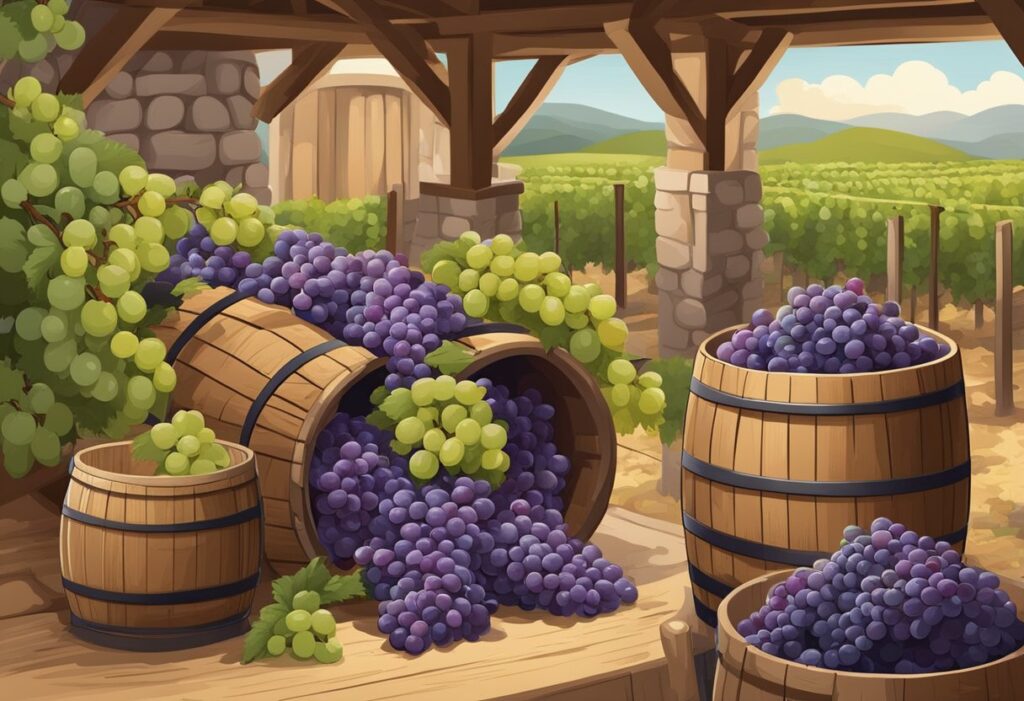
In the Middle Ages, your winemaking ancestors utilized a variety of techniques that combined time-honored traditions with emerging innovations, many of which remain integral to the process today.
Traditional Methods and Innovations
Historically, winemakers engaged in grape treading, employing large tubs where they meticulously crushed grapes underfoot. This method ensured the release of juice pivotal for fermentation. Beyond the physical labor of grape treading, medieval winemakers embraced innovative techniques such as using sulfur as a stabilizer for the wine, hinting at early forms of wine conservation. These methods not only facilitated wine production but also influenced its taste and longevity.
The Role of the Wine Press
The wine press—a significant technological advancement—transformed medieval winemaking. This apparatus dramatically increased efficiency, allowing winemakers to extract more juice and produce wine in larger quantities.
The wine press saw various iterations and improvements over time, which aided in defining wine characteristics and enabling superior control over the winemaking process. Its emergence marks a pivotal transition from purely manual methods to semi-mechanized production, shaping the future of viticulture.
Trade and Economy
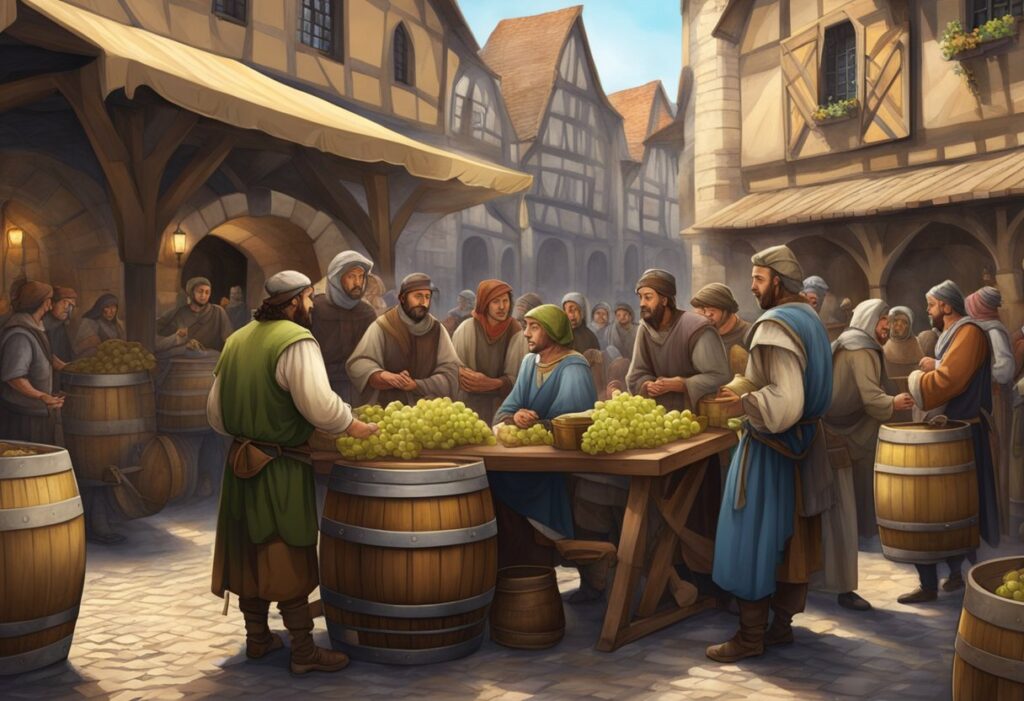
In the Middle Ages, wine was not just a staple drink but also a significant economic driver. Your understanding of medieval trade would be incomplete without considering the complex networks that circulated this cherished commodity.
Local and Long-Distance Trade
The wine trade was instrumental in medieval society, connecting local economies to larger, long-distance markets. Wine was a common commodity in local markets, often produced by monasteries with their own vineyards. Monastic communities prided themselves on the quality of their wine, which they traded to support their religious institutions.
On a larger scale, wines, especially those from renowned regions such as Bordeaux, were treasured items in long-distance trade. Shipments of fine wine crossed seas and navigated through an intricate web of trade routes.
The longevity of wine as a trade good made it a suitable candidate for extended trade. Notably, vessels such as amphorae were critical in preserving and transporting wine over long distances, ensuring that it reached consumers in optimal condition. The cost of sea transport was significantly less than land, reinforcing the prominence of maritime trade until the advent of the railways.
Hanseatic League’s Involvement
The Hanseatic League, a powerful mercantile and military network of the medieval period, played a pivotal role in the expansion of the wine trade. This alliance of cities and guilds established extensive trade routes across the Baltic and North Seas.
The League’s influence meant that it could command trading terms favorable for its members, which included key wine-trading cities. Their trading posts served as hubs for the distribution of various goods, including wine, which they sourced from regions renowned for their vineyards.
Aside from enhancing the reach and efficiency of trade, the Hanseatic League enforced regulations and standards, crucial for maintaining the quality of wine that reached the markets. This underscored the trustworthiness of wine traded through their networks, ensuring consumers received quality products, a testament to the League’s commitment to maintaining its reputation as a reliable trading partner.
Societal and Cultural Aspects
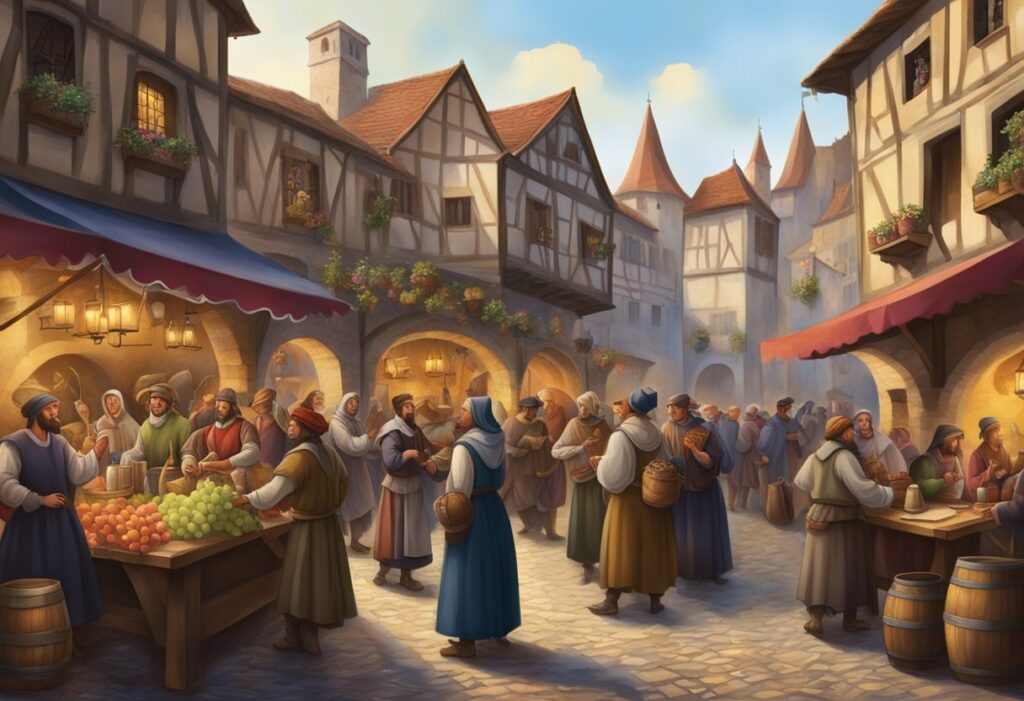
Wine played a multifaceted role in the Middle Ages, deeply intertwined with religious rites and social hierarchies.
Wine in Religion and Ceremonies
In the Christian Church, wine was a sacred substance, central to the celebration of the Eucharist. You might be aware that during Mass, wine is consecrated to represent the blood of Christ, a practice rooted in the Last Supper narrative.
This ritual underscores the spiritual significance of wine, positioning it as an essential element of Christian worship and communal gatherings. Similarly, in Islam, despite the prohibition of alcohol, historically, there were periods and places where wine poetry flourished, as wine often symbolized spiritual intoxication.
Wine as a Symbol of Status
For the nobility, wine served as more than just a drink; it was a symbol of wealth and status. Feasts and banquets would commonly feature exquisite wines to flaunt the host’s affluence and to provide a luxurious experience to guests.
It became customary for the upper classes to have an extensive knowledge of different types of wines, turning the beverage into a status symbol. Not to mention, the wine trade was a lucrative endeavor for those who could afford the investment, further entrenching its association with the noble class.
Wine Varietals and Traits
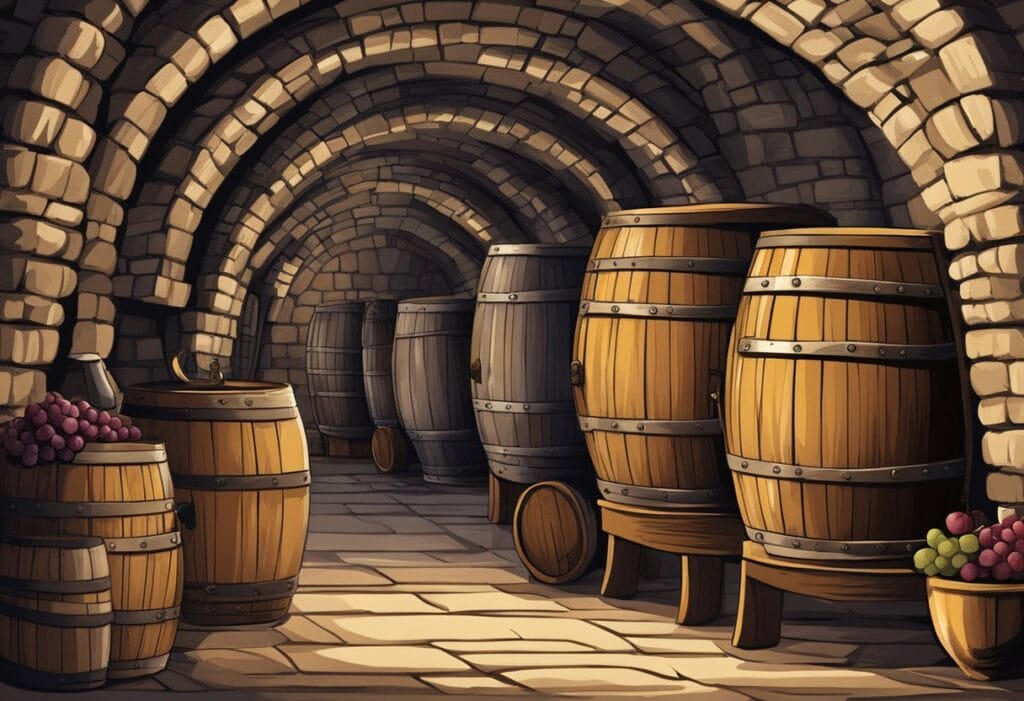
In the Middle Ages, wine was not just a beverage but a reflection of culture and horticultural advancements. You’ll discover how certain varietals developed and the role of flavorful additions that characterized medieval winemaking.
Development of Riesling
The Riesling grape began its ascent in regions such as the Rhine Valley, gaining a reputation for high quality.
- Historical records suggest that Riesling development took significant strides around the 15th century.
- The grape thrived in cooler climates, leading to expressions of wine with notable acidity and aromatic complexity.
By understanding Riesling’s early development, you can appreciate its enduring legacy in today’s wine culture.
Spices and Flavoring in Wine
In the realm of medieval winemaking, the use of spices and flavorings was commonplace to enhance or preserve wines.
- Spices like cinnamon, ginger, and ground cloves were often part of the blend to create a distinctive taste profile.
- This practice also helped mask the taste of spoilage in a time before modern storage and fermentation techniques.
Your awareness of these historical details enhances your understanding of the evolution of flavored and spiced wines.
Health and Consumption
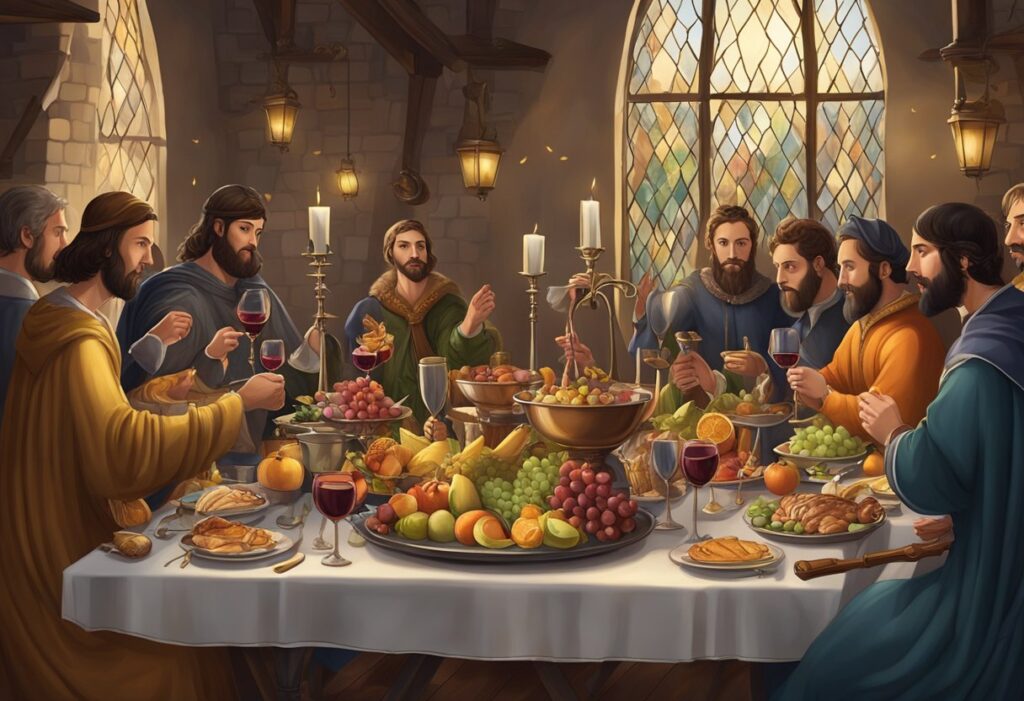
In the Middle Ages, wine played a pivotal role both as a beverage integral to daily life and as a therapeutic agent. You will find that the medicinal applications were diverse, and consumption habits varied widely.
Wine’s Medicinal Roles
Medieval physicians commonly prescribed wine for its medicinal use, leveraging its perceived benefits in digestion and general health. Wine was administered to fortify the body, aid in the digestion of food, and to refresh the spirits. For example, medical texts from the era suggest wine could be used to clean wounds and as part of treatment regimens for various illnesses. It was believed that the qualities of wine had the potential to balance the body’s humors.
Wine Consumption Patterns
Your forebears in the Middle Ages didn’t just consume wine for health; it was also a daily staple for hydration and nourishment. Clean water was not always readily available, making wine a safer alternative. The consumption took place across all classes of society, with the quality and quantity varying significantly.
The nobility often had access to finer vintages, while commoners drank what was affordable and available, sometimes even diluted versions to make supplies last. Feasts and celebrations would see increased wine consumption, reinforcing its role in social contexts.
Comparative Drinking Trends
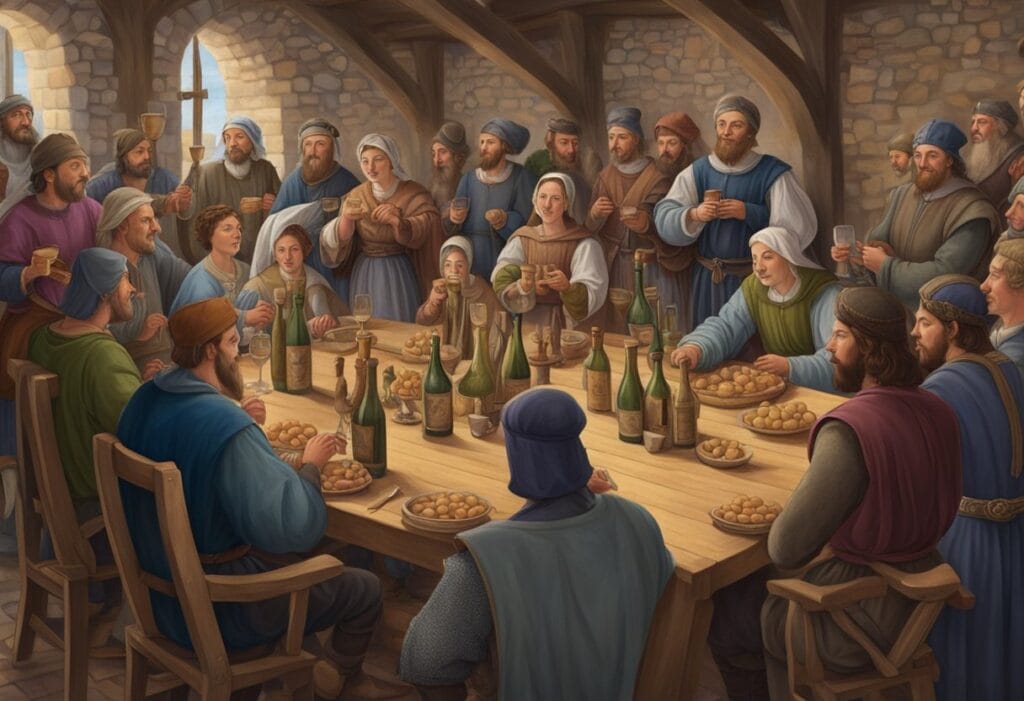
In the Middle Ages, your choice between wine and beer wasn’t just a matter of taste—it was influenced by geography, social class, and religion.
Wine Versus Beer Dynamics
Wine was often seen as a more sophisticated drink associated with the upper classes and warmer regions where grapes were easily cultivated. Conversely, beer was commonly consumed by the masses and was especially prominent in areas less suitable for viticulture. You would find that beer, being cheaper and more readily available, was the everyday beverage for many, while wine might be reserved for special occasions or enjoyed by those with greater means.
Influence of Religious Contexts
The Christian Church played a significant role in the production and consumption of wine. Wine held religious significance, as it was necessary for the sacrament of the Eucharist. Within Islamic regions, where alcohol was generally prohibited, the consumption of wine was considerably lower due to religious doctrines.
Nevertheless, it’s intriguing to note that even in some of these areas, medicinal use of wine was sometimes permitted, showcasing the nuanced relationship between religion and alcohol consumption in your time.

